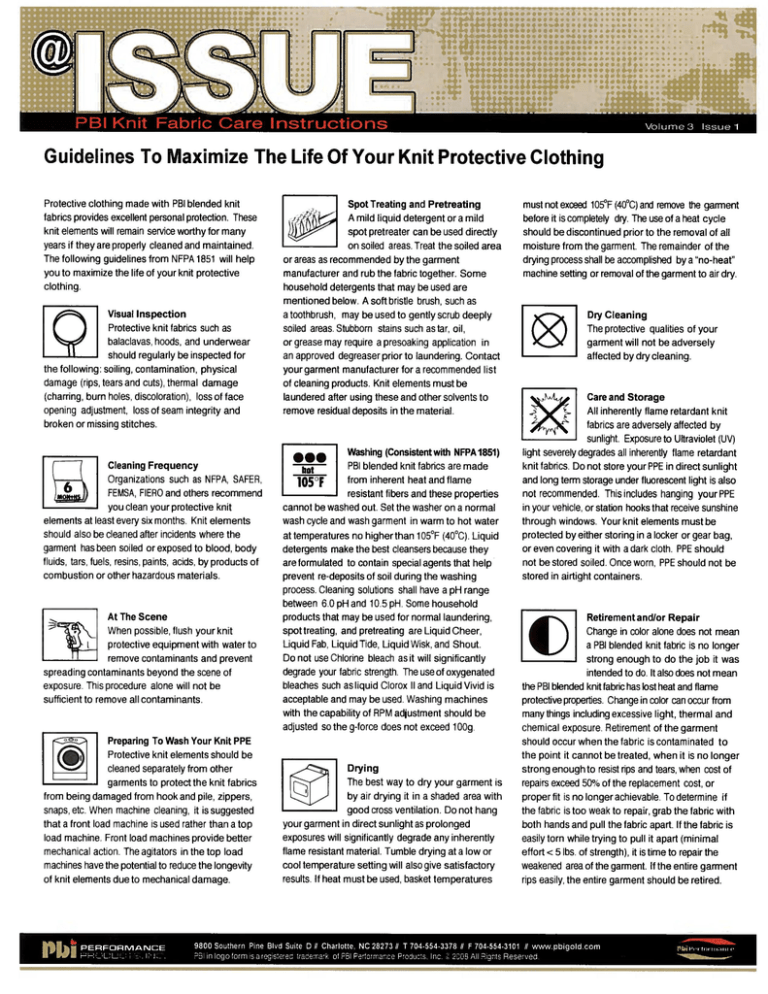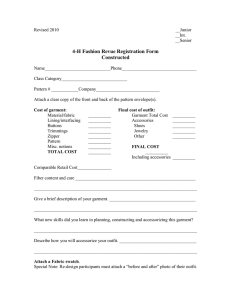PBI Knit Fabric Care Instructions
advertisement

...we/v., • 411,z4A-4..a.A. • e. • Dee,(• OW. • •••• 4 . 144:011.0... Iii :3096.00 I • 0.• • •• •• 0 ••• • • • • • • 4:: .114V, ::=4 ••••••••••• • frig orii s 0 .0 •• •••• ....•...•••... H AWN •• OV::1:::::::: n :::. *Mb, OS 4••••••••141. • • ••• •• • • * *O., • •••• •••• •• •• s.• • • :!1::ItS • 011,0 e • ••• 4 II Oe • ti4 PBI Knit Fabric Care Instructions Guidelines To Maximize The Life Of Your Knit Protective Clothing Protective clothing made with Plifiblended knit fabrics provides excellent personal protection. These knit elements will remain service worthy for many years if they are properly cleaned and maintained. The following guidelines from NFPA 1851 will help you to maximize the life of your knit protective clothing. Visual Inspection Protective knit fabrics such as balaclavas, hoods, and underwear should regularly be inspected for the following: soiling, contamination, physical damage (rips, tears and cuts), thermal damage (charring, burn holes, discoloration), loss of face opening adjustment, loss of seam integrity and broken or missing stitches. Cleaning Frequency Organizations such as NFPA, SAFER, FEMSA, FIERO and others recommend you clean your protective knit elements at least every six months. Knit elements should also be cleaned after incidents where the garment has been soiled or exposed to blood, body fluids, tars, fuels, resins, paints, acids by products of combustion or other hazardous materials. At The Scene When possible, flush your knit protective equipment with water to remove contaminants and prevent spreading contaminants beyond the scene of exposure. This procedure alone will not be sufficient to remove all contaminants. Preparing To Wash Your Knit PPE Protective knit elements should be cleaned separately from other garments to protect the knit fabrics from being damaged from hook and pile, zippers, snaps, etc. When machine cleaning, it is suggested that a front load machine is used rather than a top load machine. Front load machines provide better mechanical action. The agitators in the top load machines have the potential to reduce the longevity of knit elements due to mechanical damage. Pin PERFORMANCE Spot Treating and Pretreating A mild liquid detergent or a mild spot pretreater can be used directly on soiled areas. Treat the soiled area or areas as recommended by the garment manufacturer and rub the fabric together. Some household detergents that may be used are mentioned below. A soft bristle brush, such as a toothbrush, may be used to gently scrub deeply soiled areas. Stubborn stains such as tar, oil, or grease may require a presoaking application in an approved degreaser prior to laundering. Contact your garment manufacturer for a recommended list of cleaning products. Knit elements must be laundered after using these and other solvents to remove residual deposits in the material. 000 but Washing (Consistent with NFPA 1851) P81 blended knit fabncs are made from inherent heat and flame 1051 resistant fibers and these properties cannot be washed out. Set the washer on a normal wash cycle and wash garment in warm to hot water at temperatures no higher than 105°F (40°C). Liquid detergents make the best cleansers because they are formulated to contain special agents that help prevent re-deposits of soil during the washing process Cleaning solutions shall have a pH range between 6.0 pH and 10.5 pH Some household products that may be used for normal laundering, spot treating, and pretreating are Liquid Cheer, Liquid Fab, Liquid Tide, Liquid Wisk, and Shout. Do not use Chlorine bleach as it will significantly degrade your fabric strength. The use of oxygenated bleaches such as liquid Clorox II and Liquid Vivid is acceptable and may be used. Washing machines with the capability of RPM adjustment should be adjusted so the g-force does not exceed 100g. 1 Drying The best way to dry your garment is by air drying it in a shaded area with good cross ventilation. Do not hang your garment in direct sunlight as prolonged exposures will significantly degrade any inherently flame resistant material. Tumble drying at a low or cool temperature setting will also give satisfactory results. If heat must be used, basket temperatures must not exceed 105°F (40°C) and remove the garment before it is completely dry. The use of a heat cycle should be discontinued prior to the removal of all moisture from the garment The remainder of the drying process shall be accomplished by a "no-heat" machine setting or removal of the garment to air dry. Dry Cleaning The protective qualities of your garment will not be adversely affected by dry cleaning. Care and Storage All inherently flame retardant knit fabrics are adversely affected by sunlight. Exposure to Ultraviolet (UV) light severely degrades all inherently flame retardant knit fabrics. Do not store your PPE in direct sunlight and long term storage under fluorescent light is also not recommended. This includes hanging your PPE in your vehicle, or station hooks that receive sunshine through windows. Your knit elements must be protected by either storing in a locker or gear bag, or even covering it with a dark cloth. PPE should not be stored soiled. Once worn, PPE should not be stored in airtight containers. Retirement and/or Repair Change in color alone does not mean a P81 blended knit fabric is no longer strong enough to do the job it was intended to do. It also does not mean the Plillblended knit fabric has lost heat and flame protective properties. Change in color can occur from many things including excessive light, thermal and chemical exposure. Retirement of the garment should occur when the fabric is contaminated to the point it cannot be treated, when it is no longer strong enough to resist rips and tears, when cost of repairs exceed 50% of the replacement cost, or proper fit is no longer achievable. To determine if the fabric is too weak to repair, grab the fabric with both hands and pull the fabric apart. If the fabric is easily torn while trying to pull it apart (minimal effort < 5 lbs. of strength), it is time to repair the weakened area of the garment. If the entire garment rips easily, the entire garment should be retired. 9800 Southern Pine Blvd Suite D // Charlotte, NC 28273 // T 704-554-3378 // F 704-554-3101 // www.pbigold.com PBI in logo form Is a reglsterec tracematk of FBI Fed ormacce Products. Inc 0 2008 All Rugrts Reserved -•••• •••111111111.....

